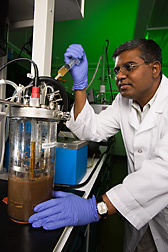This page has been archived and is being provided for reference purposes only. The page is no longer being updated, and therefore, links on the page may be invalid.
Read the magazine story to find out more. |
|
|
Retooled Approach May Make Bio-based Butanol More Competitive with Ethanol
By Jan SuszkiwOctober 16, 2008
A modified method of producing biobutanol could make the fuel more competitive with ethanol as a clean-burning alternative to gasoline.
According to Agricultural Research Service (ARS) chemical engineer Nasib Qureshi, biobutanol offers several advantages. It can be transported in existing pipelines, it's less corrosive, it can be mixed with gasoline or used alone in internal combustion engines, and it packs more energy per gallon than ethanol.
Until the mid-20th century, biobutanol was produced from fermented sugars such as corn glucose. But low yields, high recovery costs and petroleum's increased availability after World War II sidelined fermentation-based systems for biobutanol production.
Today, petroleum price increases have rekindled interest in tapping butanol as a biobased fuel, notes Qureshi, with the ARS National Center for Agricultural Utilization Research in Peoria, Ill. In 2003, he began researching the use of wheat straw to make biobutanol—drawn by the straw's abundance and promise as a lower-cost alternative to corn-glucose-based feedstocks.
Like other biobutanol processes, his approach employed Clostridium bacteria to carry out the critical task of fermentation. Such processes normally involve four preparatory steps (pretreatment, hydrolysis, fermentation and recovery) carried out separately and sequentially. But Qureshi and colleagues devised a way to combine three of the four steps. For example, enzymes and the bacteria are allowed to carry out their respective tasks simultaneously. Throughout, a procedure known as "gas stripping" is used to extract the biobutanol as it is produced.
In early trials, the method increased biobutanol productivity by twofold above traditional glucose-based fermentation. A later adjustment, dubbed "fed-batch-feeding," increased production even further. For example, during a 22-day fed-batch operating period, a culture of C. beijerinkcii P260 converted nearly 430 grams of sugar into 192 combined grams of acetone, biobutanol and ethanol.
If scaled up further, the process could yield 99 gallons of these three chemicals from one ton of wheat straw.
Read more about the research in the October 2008 issue of Agricultural Research magazine.
ARS is a scientific research agency of the U.S. Department of Agriculture.

